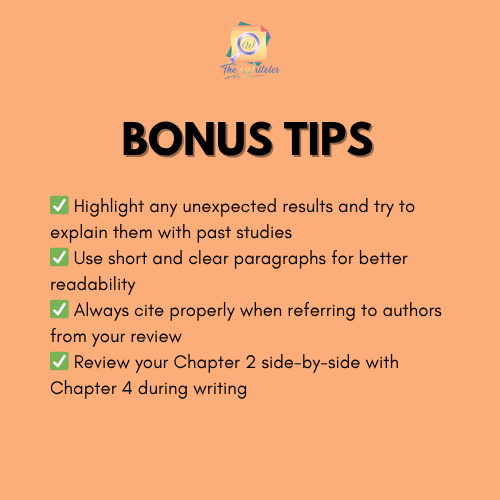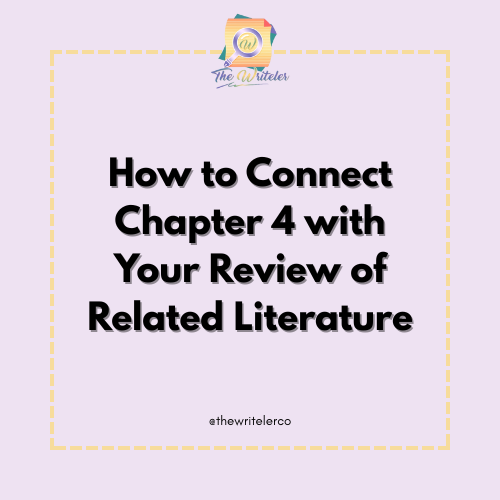Writing a research paper or thesis involves more than just collecting data. To create a strong and meaningful study, you must connect your Chapter 4 results with your review of related literature from Chapter 2. This link shows how your findings support, extend, or challenge what has already been said by others.
But how do you do that without sounding repetitive or forced? In this guide, you’ll learn why the connection matters, how to make it smoothly, and what common pitfalls to avoid.
Understanding Chapter 4 and the Review of Related Literature
Before we dive into the connection, let’s first recall what each chapter is for.
Chapter 2 – The Review of Related Literature
Your review of related literature summarizes previous research on your topic. It builds the foundation for your study by:
- Showing what others have done
- Identifying knowledge gaps
- Establishing theories and frameworks
- Defining variables and constructs
Chapter 4 – The Results and Findings
Meanwhile, Chapter 4 presents your findings. These can be numbers (from surveys or experiments) or themes (from interviews or observations). This chapter answers your research questions using the tools and methods you explained earlier.
So why should these two chapters be connected? Let’s find out.
Why Connect Chapter 4 to the Review of Related Literature?
Although it may seem like the review of related literature belongs only in Chapter 2, that’s not true. In fact, bringing it back in Chapter 4 adds depth and clarity to your results.
Here’s why the connection is important:
- ✅ It shows you’ve done your homework
- ✅ It allows readers to see the bigger picture
- ✅ It proves your findings are not random
- ✅ It helps bridge Chapter 4 to Chapter 5 (discussion and interpretation)
When you connect results to past research, your study becomes more credible and meaningful.
How to Connect Results with Your Review of Related Literature
Here are simple and practical ways to connect your findings to the review of related literature:
1. Reuse Keywords and Themes
First, go back to Chapter 2 and take note of key terms, authors, or theories. If you discussed “self-efficacy” or “constructivism” in your review, mention those again when presenting your results.
Example:
“As previously explained in the review of related literature, Bandura’s theory of self-efficacy is relevant here…”
2. Highlight Similarities and Differences
If your findings support past studies, say so. If they contradict them, that’s worth noting too.
Example:
“This result is consistent with the findings of Cruz (2021), as discussed in the review of related literature…”
Or:
“Contrary to the review of related literature, this study found no significant difference…”
3. Use a Table for Direct Comparison (Optional)
For qualitative or thematic studies, a table comparing past findings and your current ones can help visualize connections.
4. Use Linking Phrases
To create a seamless flow, try these transitions:
- “In alignment with the literature…”
- “This expands on…”
- “As noted in Chapter 2…”
- “This supports the earlier theory discussed by…”
Common Mistakes to Avoid When Connecting to the Review of Related Literature
Many students struggle to make this connection smooth and natural. Avoid these common errors:
- ❌ Ignoring the literature completely in Chapter 4
- ❌ Using outdated sources from Chapter 2
- ❌ Forcing comparisons that don’t really exist
- ❌ Repeating the same citations too often without adding new insights
Instead, aim for a balance. Mention the literature just enough to show relevance—but focus on what your data is saying now.
Extra Tips for Seamless Integration

✍️ Get Help from The Writeler Co. Writing Services
The Writeler Co. is here to support students and professionals who are juggling research with work, life, and business. Whether you’re writing a thesis, capstone, or dissertation for your master’s or Ph.D., we help you efficiently navigate the research journey — from brainstorming to proofreading.
📩 Message us today to get started.
📚 Let’s turn your research idea into a powerful paper.
Conclusion
In summary, don’t leave your review of related literature behind once you reach Chapter 4. Instead, use it to strengthen your findings, make your arguments clearer, and prepare for a powerful discussion chapter.
Connecting the dots between what was said and what you discovered is what transforms a research paper from ordinary to excellent.
Take your time, use transitions, and refer back to what you built in Chapter 2. With thoughtful writing—and a bit of help from The Writeler Co.—your paper will stand out for all the right reasons.





0 Comments